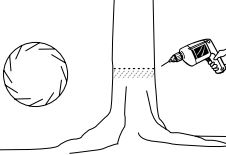Stem injection

Stem injection involves drilling or cutting through the bark into the sapwood tissue in the trunks of woody weeds and trees. Herbicide is immediately placed into the hole or cut. The aim is to reach the sapwood layer just under the bark (the cambium growth layer), which will transport the chemical throughout the plant.
It is essential to apply the herbicide immediately (within 15 seconds of drilling the hole or cutting the trunk), as stem injection relies on the active uptake and growth of the plant to move the chemical through its tissue.
Stem injection methods kill the tree or shrub where it stands, and only trees and shrubs that can be safely left to die and rot should be treated this way. If the tree or shrub is to be felled, allow it to die completely before felling. The use of chainsaws, particularly in the felling of trees, is a dangerous activity that should only be undertaken by an appropriately trained person.
One method is the ‘drill and fill method’ also referred to as tree injection, and is used for trees and woody weeds with stems or trunks greater than 5 cm in circumference. A battery-powered drill is used to drill downward-angled holes into the sapwood about 5 cm apart. The placement of herbicide into the hole is usually made using a backpack reservoir and syringe that can deliver measured doses of herbicide solution.
Another method is the ‘axe cut method’ which involves cutting through the bark into the sapwood tissue in the trunk, and immediately placing herbicide into the cut. This method can be used for trees and woody weeds with stems or trunks greater than 5 cm in circumference. Using an axe or tomahawk, cuts are made into the sapwood around the circumference of the trunk at waist height. While still in the cut, the axe or tomahawk is leaned out to make a downward angled pocket which will allow herbicide to pool. The herbicide is then immediately injected into the pocket. Cuts should be made no further than 3 cm apart. This method of using an axe to make the cut is often referred to as frilling or chipping. A hammer and chisel can be used to make the pocket cuts, or a spear to make cuts in the trunk closer to ground. It is important not to entirely ringbark the trunk, as this will decrease the uptake of the herbicide into the plant.

